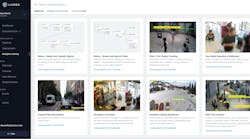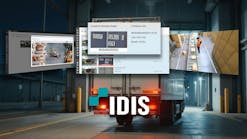This article originally appeared in the September 2021 issue of Security Business magazine. When sharing, don’t forget to mention Security Business magazine on LinkedIn and @SecBusinessMag on Twitter.
For many years now, I have participated as a judge for the Security Industry Association (SIA)’s New Product Showcase (NPS), held annually at the ISC West trade show. For those unfamiliar, the NPS is an opportunity for manufacturers to present their newest products, commercially available at the time of the show.
I have always found that volunteering for the event is well worth the time and effort. As a consultant, knowing where technology is and where it is headed allows me to make better recommendations to clients. Over the years, some incredible products have come through the NPS – many of which I have had the opportunity to specify. This year’s NPS – though conducted virtually for the second year in a row – did not disappoint.
Winning this year’s coveted Best in Show Award was Lumeo, a platform for rapidly developing and deploying custom video analytic solutions.
The Evolving Analytics Market
Video analytics and the security industry have a tenuous history. Early offerings looked dazzling in lab-concocted mockups but failed to meet expectations in real-world scenarios, where complicating factors like poor lighting and unpredictable scene elements led to high rates of false positives and negatives. The required compute power and licensing costs were high for such an error-prone tool, and many were quick to abandon analytics altogether.
Of course, the application of artificial intelligence and machine learning on a massive scale have helped to refine analytics over the years, and the processing power built into many of today’s cameras even enable some analytics to be run directly onboard.
Memories of past challenges have waned, and analytics have evolved to become an important tool in every practitioner’s toolchest.
None of this means there isn’t room for improvement, of course. One of the issues with today’s analytics environment is that each analytic generally exists to perform one function, such as face detection, people counting, color determination. What if an end-user wants to apply a series of analytics to one camera feed? For example, a retailer with a point-of-sale installation might be interested in counting people, dwell time and line length. Another retailer might be interested in classifying the age or gender of shoppers while also creating heat maps of the shop.
Also, most licensing models for high-end analytics remain inflexible, and technical requirements are often ambiguous.
Lumeo Looks to Change the Paradigm
Lumeo (http://lumeo.com) is looking to disrupt the status quo with a platform that allows the rapid development, deployment, and integration of complex analytic models. “Our goal is to make AI-based video analytics more accessible and more flexible, so that they can be used to solve a wider set of business problems, for a larger set of customers,” explains CEO and co-founder Devarshi Shah.
At the core of Lumeo is its intuitive dashboard. Each analytic from Lumeo’s extensive library can be “dragged and dropped” onto a video feed to build a custom tool incorporating multiple analytics. “Lumeo provides building blocks for analytics that allows for analytics to ‘bend’ – whereas traditional off-the-shelf analytics are one size fits all,” Shah says. “Lumeo can take any existing analytic and build on them easily with the drag-and-drop tool to produce a custom solution to solve a multitude of customer pain points. The net result is a platform that gives companies – no matter who they want for vendors or whatever technology requirements they may have – a single tool to design and deliver solutions in minutes, and without the enormous engineering effort that would be required otherwise.”
As for integrating Lumeo into an existing video surveillance environment, that process is simplified as well. End-users can run their custom-built solutions on-site using their own hardware, or they can send video to Lumeo’s cloud-processing architecture.
“Our platform is flexible – you design an analytics solution in the cloud and deploy it on-prem via GPUs or AI gateways, or in Lumeo's cloud or their own,” Shah says. “This flexibly allows customers the ability to optimize for the convenience of cloud or the cost of edge.”
As for integration, “You can ingest streams, process it with Lumeo and export RTSP streams back to NVRs and VMS for a single pane of glass experience,” Shah says. “You can also take the analytics metadata and send it to VMS or business intelligence systems of your choice via APIs.”
An important part of Lumeo’s secret sauce is curating its analytic library. “We make a wide range of analytics building blocks available to customers that they can use to build the solution they need,” Shah says.“We have dozens of these building blocks available in our library, with more being added each week. They span AI models, pre-built analytics, utilities and integrations. Some of our models are built in-house, and others we curate from openly available models and partners. So as other companies create state-of-the-art AI, we can easily integrate it and make it available to any customer.”
Shah says AI models are available that can detect people, faces, vehicles, hard hats or face masks. Other available utilities can transform video – such as blurring specific objects, pre-built analytic blocks like line crossing, object counting, wait time monitoring, license plate recognition etc. Integrations enable users to trigger alerts or send this data to other systems. Pricing is one flat rate per feed with “all you can eat” analytics, and an additional fee if Lumeo is handling the video processing in the cloud.
“We have been working with a high-volume mall that first implemented Lumeo to track how many people entered and exited through which doors,” Shah says. “Then the mall asked if we could measure the customer experience at their center kiosk – so we took the following analytics to create one simple one to deploy: line queue, line crossing, people counting, face blurring and loitering.”
Brian Coulombe ([email protected]) is Principal and Director of Operations at Ross & Baruzzini | DVS. Connect with him on Linkedin at www.linkedin.com/in/brian-coulombe or Twitter, @DVS_RB.






